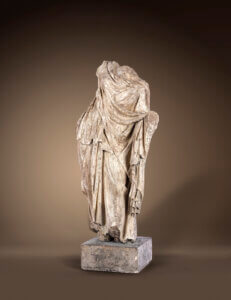This high-quality torso is a depiction of a goddess. The standing goddess is shown in contrapposto: the left free leg emerges from beneath the tight-fitting robe, while the right supporting leg takes up the curve of the hip. Her curvy posture suggests that she is supporting herself with her left hand, while her right hand is raised above her head in contrast. The pose is comparable to a standing female figure from the 1st century AD (Louvre, Paris inv. no. MR 298; N 410; Ma 414). This could be Venus, the goddess of love, leaning lasciviously against a column with her hand clasped behind her head. One of the Muses could also be depicted; they are regarded as patron goddesses of the arts from the entourage of Apollo, the god of prophecy. The female figure is possibly presenting her attribute to the viewer with her right hand stretched upwards.
The goddess wears Greek garb, namely a light chiton that models her breasts in lush folds and falls to the ground in rich drapery. The wide, heavily pleated coat, also known as a himation, covers her shoulders and forms a wide transverse pleat at the waist that rests on her outstretched left arm. Here the coat falls diagonally, revealing the belted undergarment, the puff of which falls down over the hips. Such clothing is characteristic of Roman statues, which were influenced by Greek sculpture of the Hellenistic period (334-30 BC). Particularly striking is the echo of the so-called “wet” style, which emphasizes rather than conceals the body shapes of female figures through the application of a thin, seemingly wet garment. Such statues were particularly popular in Gaul in the first half of the 2nd century.
It could be a representation of a goddess from a temple complex. It is possible that invaders could have found this statue in the late 2. or 3rd century, and their fragments were subsequently buried on the temple grounds, as was customary. The fact that this is a ground find is clearly evident from the preserved patina. The carved limestone possibly originates from the French Norroy in northern Gaul, where limestone was used instead of the marble typical in Italy. The torso of Fortuna from northern Gaul in the Gallo-Roman Museum in Tongern, Belgium (inv. no. 69.A.4), for example, is very similar. The triangular folds of the garment at the décolleté, the cloak draped diagonally across the upper body, the V-shaped bowl pleats along the waist and the straight pleated ridges with deep recesses are comparable. However, the figure presented here is particularly captivating due to the feminine and harmonious curves of the body with the clinging fabric and the manneristically draped tubular folds of the falling cloak. A first-class example of antique sculpture!
Literature:
A. Cahen-Delhaye, Le cavalier aux géants anguipèdes et trois autres statues gallo-romaines de Tongres, in: Archaeologia Belgica 219, 1979, pp. 19-23.
Marcel Pobé, The Art of Roman Gaul. A Thousand Years of Celtic Art & Culture, Toronto 1961.
LINKS:
